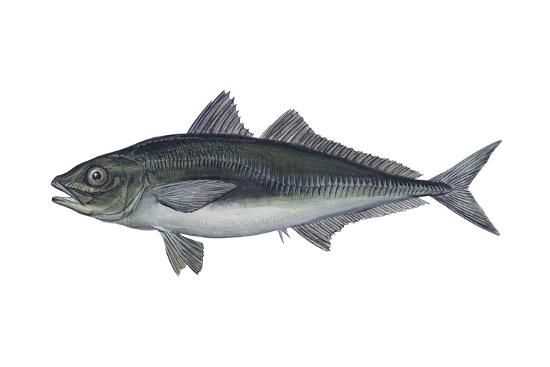Pacific Jack Mackerel

Species Details
Trachurus Symmetricus
Carangidae
Perciformes
Offshore
4 - 5 lbs.
22" - 32"
Pacific Jack Mackerel (Trachurus symmetricus) Fish Description
The Pacific Jack Mackerel is a medium-to-large size pelagic fish species that looks quite similar to most of the species in the Trachurus genus. The coloring of its back range from metallic blue to olive green, fading to a silver to white on its sides and belly.
The two dorsal fins on this fish species are quite separate from each other, with the second dorsal fin having 31 to 35 soft rays next to it. The Pacific Jack Mackerel is also characterized by the attachment of the rays of the second dorsal fin and anal fins to its body, which keeps it distinct from the Mexican or Amberstripe Scad, for which it is always mistaken. The Mexican Scad has only isolated finlets for its rays.
The Pacific jack mackerel is not a mackerel but a jack belonging to the Carangidae family.
Size and Diet
The Pacific Jack Mackerel is a medium-to-large fish species. It can grow to a length of 32 inches, but on average, it can measure at 22 inches or below. This fish species is reported to live up to 30 years old, but it matures quite young at one to three years of age.
The Pacific Jack Mackerel commonly consumes crustaceans, baby squids, anchovies, lanternfish, and small mollusks.
Interesting Facts about the Pacific Jack Mackerel
- The Pacific Jack Mackerel initially had the nickname horse mackerel, but this unfortunate name made it less appealing commercially. So in 1948, its name on food packaging was changed to jack mackerel upon the US FDA’s approval. This, along with the fact that fishers were catching more and more of the fish species, allowed the Pacific Jack Mackerel to be a significant fish catch commercially.
- The Pacific Jack Mackerel is a schooling fish. The vertical stripes found on its sides help it stay in formation while schooling.
- While the Pacific Jack Mackerel is popular as food in Japan, it has yet to gain the same traction in the US. It is reported to have the same amount of omega-3 fats like salmon, making it a good alternative for the latter.
- When fresh, the Pacific Jack Mackerel tastes really delicious. It can also be great grilled, and can be used as an alternative to the salmon, tuna, or yellowtail in many recipes.
- The Pacific Jack Mackerel is found on the market as fresh, frozen, canned, and smoked. It is canned in the same way as the salmon - cleaned, gutted, and finned, then mixed in with salted water.
- This fish species, compared to tuna, is safer to eat for humans. Being a smaller fish, it is not on the top of the food chain, thus it has lower levels of mercury in its system.
- The Pacific Jack Mackerel is not a very popular game fish, but it is often used by experienced anglers as live bait for bigger fish such as Sailfish and Common Dolphinfish. They can also be used as cut bait for anglers who are bottom fishing.
- The Pacific Jack Mackerel is often caught as a bycatch on troll gears on salmon and albacore vessels.
- The Pacific Jack Mackerel is quite the spawner. A female of this fish species can lay up to 34,000 eggs every spawning event.
Fishing Technique: How to Catch Pacific Jack Mackerel
Fishing for the Pacific Jack Mackerel is especially productive during the months of July to September. It is often caught alongside Pacific Sardines and other mackerels with which it schools.
The Pacific Jack Mackerel is often baited with a live anchovy. Anglers can use various tackles, from light to medium ones with size 4- or 6 hooks when fishing for this fish species.
This fish can also be caught with lures, particularly small ones such as small feathers, bonito jigs and Scampis. Some anglers also use Sabiki or Lucky Lura-type bait leaders for rigging. Cast your rig and do a slow retrieve to see the Pacific jack mackerel follow your baited rig to the water surface.
The Pacific Jack Mackerel are also caught using round-haul gears such as purse and drum seines, lampara nets, and dip nets.
Like other mackerels, the Pacific Jack Mackerel must be put on ice as soon as it is taken out of the water because its flesh can get spoiled rather fast. This quick spoilage may also lead to bacteria development and subsequently scombrid poisoning.
Habitat and Distribution
This fish species prefers the subtropical waters at 8 degrees Celsius. Its habitat ranges from the waters of the eastern Pacific coast of Alaska all the way down to the Baja California and the Gulf of California. It also is reported to occur in the Galapagos Islands and Acapulco in Mexico.
Adult Pacific Jack Mackerel are often found traveling from 500 to 600 miles offshore, at least 1000 feet deep, in large schools. They swim inshore during the summer. Juveniles, on the other hand, like to school in waters under piers and near kelp where they feed. Species found in coastal regions are often reported to live in bays and shallow waters.





